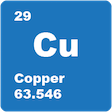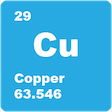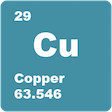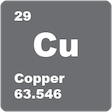SCIENCE & RESEARCH
UNTREATED
TREATED
Copper Ionization: How it works

Free copper (Cu++) is 800 times more powerful than bound copper. This allows for the control of pathogens with 1-3 PPM of free copper instead of 800-900 PPM of bound copper.

Kingdom Ion™ controls bacteria such as E. Coli, Xanthomonas, Agrobacterium, Ralstonia, Erwinia, and Clavibacter which are killed within 2-4 hour of free copper exposure.
Copper ionization does not destroy “good” bacteria, as most non-pathogenic bacteria have a gram-positive charge.

Kingdom Ion™ is able to control pathogens under the limitations of the Federal Drinking Water Standards (FDWS)
Copper Ionization reduces pressure from pests and disease, increases germination rates, and decreases the use of expensive chemicals.

The consistent and controlled supply of copper ions prevents fungal attacks as zoospores are killed instantly when exposed to free copper.
Copper Ionization increases calcium uptake.
How the Kingdom Ion™ system works
Kingdom Ion™ is plumbed into existing irrigation infrastructure directly after fertilizer or nutrition tanks and is able to be bypassed if needed.
Kingdom Ion™ produces a regulated supply of copper ions at the moment of watering, and the free copper concentration is within normal fertilizer standards.
Fungi and bacterial attacks are prevented by stabilizing the supply of copper ions which promotes healthier plants and stronger roots.
Kingdom Ion™ reduces or eliminates fungicide use.
Copper Ionization Research
Xanthomonas
At least 2 ppm Cu were necessary to affect the bacterial concentration, dependent on the exposure time (see table 3). Up to 60 min no significant differences to the control treatment could be seen. Only at exposure times from 240 min on and Cu- concentrations of 2 and 4 ppm a clear impact onto the pathogens could be detected, but no complete elimination. The corresponding efficiency rates for 2 ppm Cu were 96.5 % and for 4 ppm Cu 99.5 %. A complete elimination (efficiency rate 100 %) of the pathogens was only to be seen after an exposure time of 24 hrs (1440 min) and Cu doses of 2 and 4 ppm.
Agrobacteria
Clavibacter
Ralstonia
E. Coli
Listeria
Fusarium
Algae
Goldsmith Seeds in California has, in cooperation with Lars Marohn, made specific trials to test this effect. For Goldsmith Seeds it is important that the newly sown plants are not hampered by algae growth on the surface of the plugs.
Trays with plugs were watered for some weeks. Half with normal water and the other half with Copper Ionized water. Dosing rate 2.5 ppm.
Erwinia
Ramorum
Chalara
Iron chelates
Spidermites
© Kingdom Agriculture | Built by NICE GRIZZLY
© Kingdom Agriculture
Built by NICE GRIZZLY